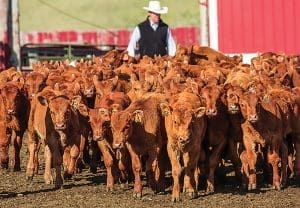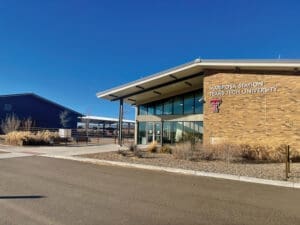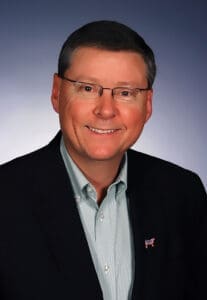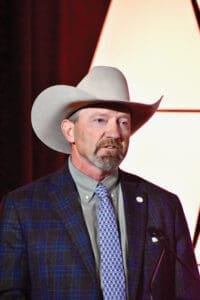By Larry Stalcup Contributing Editor

With breakevens that push $190 to $200/cwt., feedyards are seeking the best quality of cattle to place on feed. And they’re willing to pay a premium for them. As a cow-calf or stocker operator, do your calves or yearlings fit the bill?
Even with tight feeder cattle supplies, cattle buyers will likely pay the highest prices to producers with a reputation for selling quality cattle that consistently perform well. They will pay close attention to special calf sales that pool higher quality cattle, or cattle that meet specific specs for all-natural, no hormones or other specialty markets.
Tom Brink, Red Angus Association of America CEO, appreciates the growth he’s seen in programs that can produce a premium for Red Angus producers and other cow-calf and seedstock operators.
“Ten to 15 years ago, people questioned whether there was such a thing as a premium,” Brink says. “I don’t hear that anymore. Many of these programs have truly established themselves, and people know they can get paid extra for quality calves that enter the market with third-party-verified credentials.”
During a 2021 University of Nebraska webinar on adding value through approved certification programs, Brink and other speakers noted that livestock buyers are becoming more scrutinized. They want more information about cattle they bid on and eventually purchase. That trend certainly holds true in 2024.
The webinar stressed that since not all producers are equipped to evaluate cattle in a manner that can verify quality for consumers, value-added programs have grown to help producers get paid for the quality in their cattle. Third-party entities can provide producers with links to buyers who demand higher quality beef and beef that fits the taste of consumers.
Brink says value-added programs are typically available based on health, genetics, nutritional background or other specific eligibility. Some of the better established certification programs for cow-calf operations include Non-Hormone Treated Cattle (NHTC), Natural, Global Animal Partnership (GAP), Age-Source Verified, Top Dollar Angus, and of course, Certified Angus Beef (CAB).
Health-related verifications like VAC 45 and VAC 60 are highly recommended, especially if producers sell animals at lighter weights. Producing cattle that are in a certified Beef Quality Assurance operation nearly always provides the initial step in attracting cattle buyers with orders to purchase better quality animals.
Produce It and They’ll Pay

More than 75 percent of fed cattle now grade Choice and many hit the Prime mark. That’s because producers are using better genetics, preconditioning programs and other production measures to improve quality. According to CattleFax, in 2023, fed cattle that graded over 80 percent Choice brought nearly $85 per head or more, when compared to negotiated cash trade. Cattle grading at 65 to 80 percent Choice received a $45-per-head or more premium. The 35 to 65 percent Choice cattle received a $15-per-head premium over negotiated cash trade.
Many of those cattle were marketed through grids, which often include a premium for higher quality cattle and discounts for those that don’t grade as high. “If your calves are worth more after you’ve invested in better genetics and put more energy into your health program, receiving a premium is what you should continue to strive for,” Brink says.
The Red Angus Association of America has grown substantially over the past 15 years. Brink says the breed is virtually tied with Simmental as the nation’s third-largest breed association. “We have a good underlying philosophy. We operate on science-based thinking,” he says.
The Red Angus Yellow Tag program provides a premium of $3 to $4/cwt., or about $20 per head for calves. The calf certification program is a USDA process-verified program (PVP). “You have to verify your sires, so the cattle are at least 50 percent Red Angus,” Brink explains. “That provides an increased access to various Angus breeds.
“The Angus recognition is what creates the value of the tag. There is no direct enrollment fee in the program. It’s essentially the cost of the tag, whether it’s a dangle tag, an EID or a combo.”
Brink says Red Angus also has an active program with Adams Land & Cattle Co. and Tyson. “It is Tyson’s Brazen Beef program that provides sustainability claims to their customers,” he says. “We supply cattle for that program, and it provides a premium of approximately $30 per head.” (for more visit https://redangus.org).
“Ten to 15 years ago, people questioned whether there was such a thing as a premium. I don’t hear that anymore.”
– Tom Brink
What’s Your Reputation?
CAB’s ability to both promote better quality cattle and beef cuts that consumers seek has helped build a brand that revolutionized cattle production and marketing. All sectors of the industry have benefitted from its many programs to match commercial producers with seedstock operators with proven genetics. The American Angus Association’s AngusLink value-added program uses genetic merit scores and third-party verification to assure buyers they are purchasing high-quality cattle.
These and other genetic-based programs have helped producers improve their reputations. “Reputation feeder cattle are no accident,” CAB says, noting that information adds value. “Amid the marketing claims and hype, buyers are most likely to focus on cattle that add value to the best-known Angus genetics.”
To help boost the demand for a ranch’s quality cattle, CAB recommends that producers build a resume for their calves. “Whether calves will be sold at auction or private treaty, it pays to do homework on potential buyers ahead of time,” CAB points out. “A genetics and management record serves as a resume for your calves.”
Certified Hereford Beef is also among other breed-based groups that involve the production of cattle that meet consumer demands for tenderness, tastiness, proper animal welfare, environmentally friendly production techniques and other measures of sustainability. Cattle must meet strict guidelines to qualify as CHB cattle (for more visit https://www.certifiedherefordbeef.com/our-story/dare-to-be-different/).
Special Feeder Calf Sales
Brink suggests that smaller producers consider using special calf sales to pool their calves with like cattle to help attract more bidders who are seeking higher quality cattle. The Livestock Marketing Association and its many members nationwide can help producers locate special calf sales in their area (for more visit https://www.lmaweb.com/Membership/our-members).
State and regional cattle associations, along with cattle-state universities can also provide links to special cattle sales.
“It’s a good time for anyone wanting to get out of the commodity beef business,” Brink concludes. “It has never been easier to do.”






